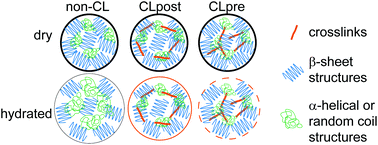Micromechanical characterization of spider silk particles†
Abstract
Spider silk fibers are well known for their mechanical properties, and they are therefore in the focus of materials scientists. Additionally, silks display biocompatibility making them interesting materials for applications in medicine or cosmetics. Due to the low abundance of natural spider silk proteins because of the spider's cannibalism, the recombinant spider silk protein eADF4 has been established for material science applications. Once processed into micron-sized particles by controlled salting-out, these particles can be used as drug delivery vehicles. For any application of the silk particles it is important to know their mechanical characteristics for processing and storage reasons. Here, we examine the swelling behavior and mechanics of these particles. Upon hydration, a drastic drop in elastic modulus occurs by orders of magnitude, from 0.8 GPa in the dry state to 2.99 MPa in the wet state. Importantly, the elastic modulus of recombinant silk particles can be tuned by varying the molecular weight of the used proteins, as well as chemical crosslinking thereof.

- This article is part of the themed collection: Silk and silk-inspired materials

 Please wait while we load your content...
Please wait while we load your content...